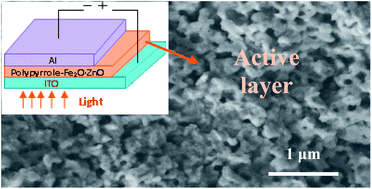Polypyrrole: FeOx·ZnO nanoparticle solar cells with breakthrough open-circuit voltage prepared from relatively stable liquid dispersions
Abstract
Organic hybrid solar cells with a large open-circuit voltage, up to above that of 1.5 V standard battery voltage, were demonstrated using blends of polypyrrole: Fe2O3·ZnO nanoparticles as active-layers. The cell active-layers were readily coated in open air from relatively stable liquid dark-color polypyrrole-based dispersions, which were synthesized using appropriate surfactants during the in situ polymerization of pyrrole with FeCl3 or both H2O2 and FeCl3 as the oxidizers. The performance of the cells depends largely on the synthesized blend phase, which is determined by the surfactants, oxidizers, as well as the reactant ratio. Only the solar cells fabricated from the stable dispersions can produce both a high open-circuit voltage (>1.0 V) and short-circuit current (up to 7.5 mA cm−2) due to the relatively uniform porous network nanomorphology and higher shunt to series resistance ratio of the active-layers. The cells also display a relatively high power-conversion efficiency of up to ∼3.8%.


 Please wait while we load your content...
Please wait while we load your content...